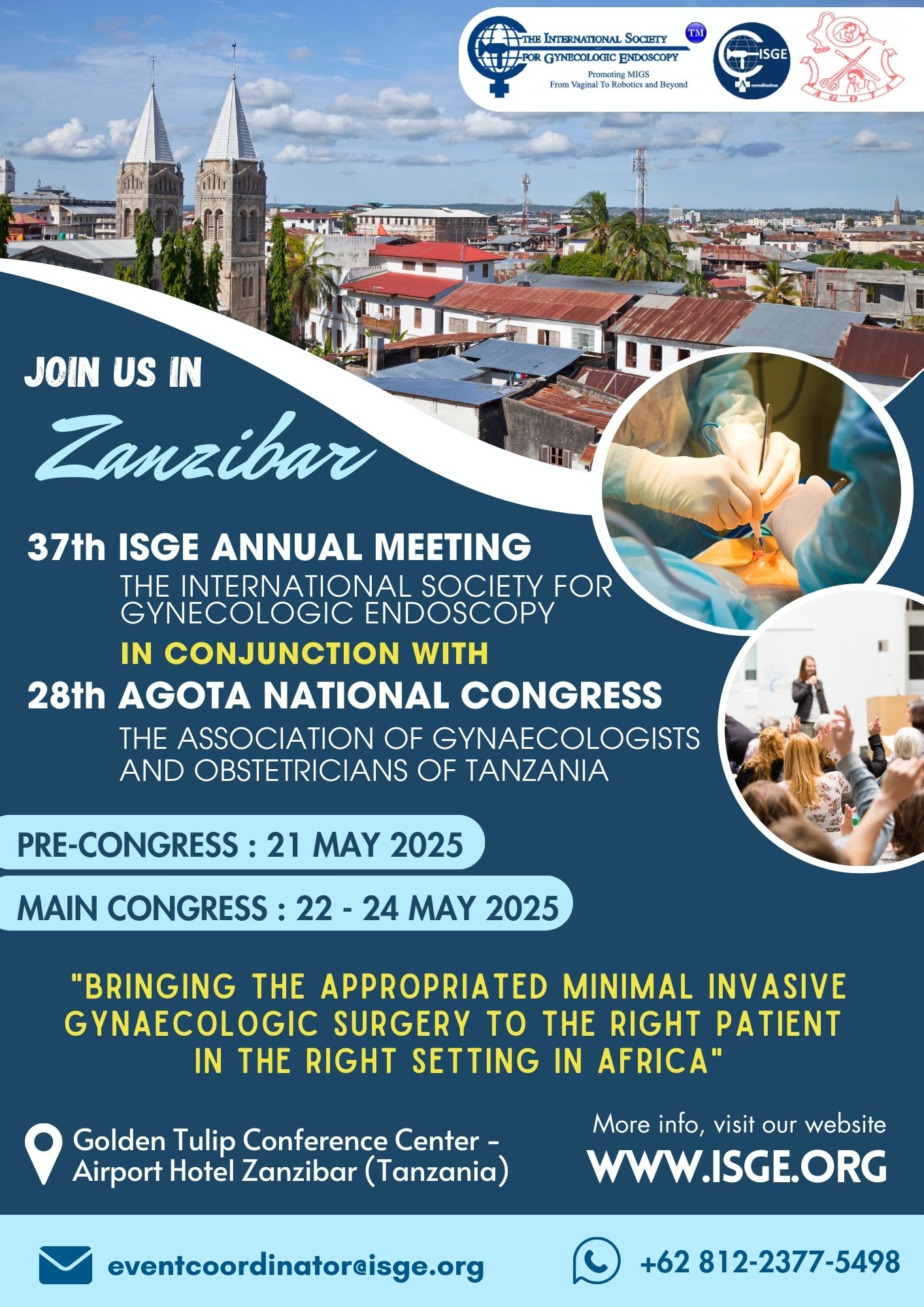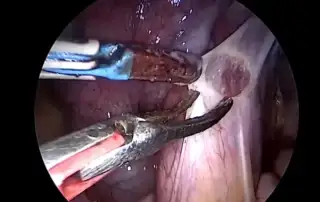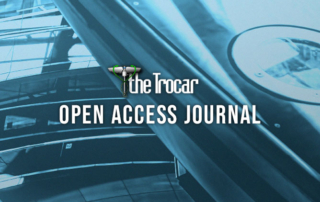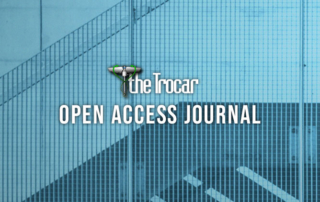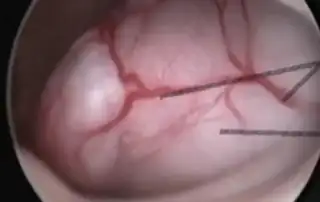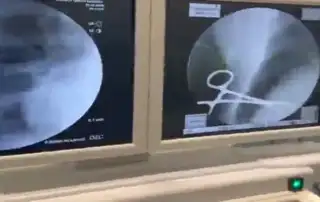This text does not offer a complete new solution, but would like to remind you that we have to critically back on at any time in order to produce the highest possible objectivity. Especially in times when factual knowledge is partially ignored, we should be able to not nourish high demands on us as a publisher for doubts. Continue reading introduction …
Anneli Linnamägi new ISGE President
Index: TheTrocar Volume 6 – Issue 2. 2025
Introduction
Article list
- Surgical Approaches in Early-Stage Cervical Cancer: Current Debates, Evidence, and Practical Recommendations
Loubna Slama
DOI 10.36205/trocar6.2025005 - Diagnostic Hysteroscopy at the Nabil Choucair Health Center: Indications, Technique, Results
Omar Gassama
DOI 10.36205/trocar6.2025007 - Microwave Ablation of Diffuse Uterine Adenomyosis: A Novel Minimally Invasive Fertility Preserving Therapeutic Approach
Sanchari Pal
DOI 10.36205/trocar6.2025008 - Beyond the Pelvis: Multidisciplinary Surgical Management of Extra Pelvic Endometriosis – A Video Case Series report
Lucia Chaul
DOI 10.36205/trocar6.2025009 - Ureteroneocystostomy in a case of deep infiltrating endometriosis (Case report + Video)
Hemant Kanojiya, Mukulika Sharma
DOI 10.36205/trocar6.2025010 - A Minimally Invasive Retroperitoneal Approach to Apical Compartment Prolapse Repair via vNOTES Sacral Fixation (Video)
Rüdiger Klapdor
DOI 10.36205/trocar6.vid25005 - Parametrectomy and discoid resection for deep endometriosis of the medial and posterior compartments using the reverse technique (Video)
Jhanneth Jhovanna Chura Paco
DOI 10.36205/trocar6.vid25006 - Spontaneous Rupture of an Unscarred Uterus at 34 Weeks of Pregnancy (Video – case report)
Meenu Agarwal
DOI 10.36205/trocar6.vid25007 - A Novel Hysteroscopic Approach for FIGO Type 2 Submucosal Leiomyomas (new approach)
Xiaoming Gong
DOI 10.36205/trocar6.2025011
Full articles open access
Ureteroneocystostomy in a case of deep infiltrating endometriosis
DOI: 10.36205/trocar5.2025010
Surgical Approaches in Early-Stage Cervical Cancer: Current Debates, Evidence, and Practical Recommendations
DOI: 10.36205/trocar5.2025005
Spontaneous Rupture of an Unscarred Uterus at 34 Weeks of Pregnancy
DOI: 10.36205/trocar6.vid25007
Saudi Hysteroscopy Guideline
DOI: 10.36205/trocar5.2025006
Parametrectomy and discoid resection for deep endometriosis of the medial and posterior compartments using the reverse technique
DOI: 10.36205/trocar6.vid25006
Microwave Ablation of Diffuse Uterine Adenomyosis: A Novel Minimally Invasive Fertility Preserving Therapeutic Approach
DOI: 10.36205/trocar5.2025008
Diagnostic Hysteroscopy at the Nabil Choucair Health Center: Indications, Technique, Results
DOI: 10.36205/trocar5.2025007
Beyond the Pelvis: Multidisciplinary Surgical Management of Extra Pelvic Endometriosis – A Video Case Series report
DOI: 10.36205/trocar5.2025009
A Novel Hysteroscopic Approach for FIGO Type 2 Submucosal Leiomyomas (new approach)
DOI: 10.36205/trocar6.2025011
A Minimally Invasive Retroperitoneal Approach to Apical Compartment Prolapse Repair via vNOTES Sacral Fixation
DOI: 10.36205/trocar6.vid25005
The Peer Review Process: Cornerstone of Scientific Integrity or Hindrance to Innovation?
This text does not offer a complete new solution, but would like to remind you that we have to critically back on at any time in order to produce the highest possible objectivity. Especially in times when factual knowledge is partially ignored, we should be able to not nourish high demands on us as a publisher for doubts.
The peer review process is universally regarded as a cornerstone of academic and scientific publishing. It ensures that research is scrutinized, validated, and improved by qualified experts before it is disseminated to the broader scientific community. The system relies heavily on voluntary contributions from scholars who lend their time and expertise without financial compensation. While the system has played a critical role in maintaining the integrity of academic literature, it is increasingly facing scrutiny over issues of bias, inefficiency, and its potential to obstruct innovation—especially in an era where open-access publishing has introduced new financial and structural dynamics.
The Foundation of Peer Review
At its best, peer review functions as a gatekeeping mechanism that preserves the quality and credibility of scientific output. Ideally, reviewers possess deep knowledge of their field, are experienced in publishing themselves, and are adept at identifying flaws in methodology, interpretation, and statistical analysis. According to the Committee on Publication Ethics (COPE), the process is intended to be objective, constructive, and confidential, and reviewers are expected to disclose conflicts of interest and maintain high ethical standards (COPE, 2017).
A study published in *Nature* (Smith, 2006) affirms that peer review is seen as the “gold standard” in scholarly publishing, but it also acknowledges the limitations and inconsistencies within the system. For instance, research has shown that reviewer recommendations often lack consistency, and papers rejected by one journal are frequently accepted elsewhere with minimal revisions (Rothwell & Martyn, 2000).
The Question of Objectivity and Bias
The ideal of objectivity is often compromised by implicit biases. Journals typically assign 2 to 3 reviewers to each submission, which in theory should mitigate individual biases. However, this small sample size is hardly sufficient to eliminate systemic biases—such as conservatism in scientific thought or favouritism toward well-known authors or institutions. Innovators presenting new concepts may find their work disproportionately rejected, not due to methodological flaws, but because their ideas challenge entrenched paradigms.
In a well-known case, Nobel laureate Barry Marshall’s early research on *Helicobacter pylori* as a cause of stomach ulcers faced rejection from traditional journals, illustrating the reluctance of peer reviewers and editors to accept paradigm-shifting work. Such examples raise the concern that peer review can sometimes act less as a gatekeeper of quality and more as a conservator of orthodoxy.
The Role of Editors and the Need for Reform?
Editorial boards play a crucial role in managing peer reviews and ensuring that innovative but methodologically sound research is not unfairly excluded. However, the increasing burden placed on volunteer reviewers and editors—particularly in high-impact journals—has led to calls for reform. Some scholars argue for professionalizing aspects of the editorial and review process, especially in light of the high fees associated with open-access publishing.
As noted in a 2021 article in Science, open-access fees can exceed \$3,000 per article, raising ethical concerns about who gets to publish and under what circumstances. If journals demand such fees, authors should reasonably expect a professional and unbiased evaluation process in return.
Toward a Professionalized and Transparent System and to address the current challenges, several reform models have been proposed:
- Reviewer Compensation: As reviewing is unpaid yet time-intensive, some have argued for financial incentives or formal academic credit (Publons and ORCID offer partial solutions by tracking reviewer contributions).
- Open Peer Review: Transparency in the review process, where reviews and reviewer identities are published, can foster accountability and reduce the potential for biased or unconstructive feedback.
- Editorial Oversight and Training: Journals could invest in training editors and reviewers to better handle interdisciplinary or unconventional research, ensuring that ideas are evaluated on merit rather than perceived orthodoxy.
Conclusion:
The peer review process remains a vital mechanism for safeguarding the quality of academic publications. However, it is not without flaws. Bias, conservatism, and inefficiencies threaten its objectivity and may hinder scientific innovation. As the publishing landscape evolves—especially under the pressures of open access—it becomes imperative to reconsider how peer review is structured, incentivized, and governed. Professionalizing and reforming the system could help maintain its integrity while fostering a more inclusive and progressive scientific community.
We also work from the review to editing to publication support on a voluntary basis. Still, we enable all members free publication and non -members a low contribution. The Editor Team is working on the review process on monitors to rule out bias as far as possible.
References:
- COPE (2017). Ethical Guidelines for Peer Reviewers. Committee on Publication Ethics. Smith, R. (2006). Peer review: a flawed process at the heart of science and journals. Journal of the Royal Society of Medicine, 99(4), 178-182.
- Rothwell, P. M., & Martyn, C. N. (2000). Reproducibility of peer review in clinical neuroscience: Is agreement between reviewers any greater than would be expected by chance alone? Brain, 123(9), 1964–1969.
- Science Magazine (2021). The Cost of Open Access: Are Publishers Doing Enough?
- Tennant, J. P. et al. (2017). A multi-disciplinary perspective on emergent and future innovations in peer review. F1000Research.
Guenter Noé
Editor in chief

